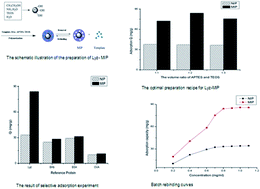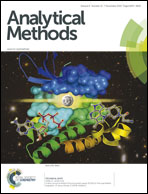Silica-based surface molecular imprinting for recognition and separation of lysozymes
Abstract
A highly selective surface molecularly imprinted inorganic polymer composed of tetraethoxysilane and 3-aminopropyltriethoxysilane has been prepared by a sol–gel process on silica submicroparticles in aqueous solution under simple and mild conditions. Lysozyme (Lyz, pI 11, MW 14.4 kDa) is used as the template protein. The product polymers were characterized by FT-IR, TEM, and TG techniques to verify the successful synthesis of the MIP on the surface of silica submicroparticles. The adsorption behavior of the MIP was evaluated by adsorption capacity, imprinting factor and adsorption model. It was found that both MIP and NIP could adsorb the template protein quickly and easily owing to the low mass transfer resistance of the thin shell and their adsorption equilibrium could be reached in 5 h. Compared with the NIP, the MIP showed stronger adsorption capacity for template protein Lyz under all experimental conditions. The mechanism for static adsorption of Lyz onto the MIP was found to follow the Langmuir adsorption model which was further used to calculate the maximum adsorption capacity Qmax and gave a result of 90.33 mg g−1 in theory. The MIP adsorbent could be reused twice without significant loss in adsorption capacity. The MIP indicated excellent recognition and binding affinity toward Lyz, whose selectivity factor β for Lyz relative to reference proteins bovine serum albumin (BSA, pI 4.9, MW 69.0 kDa), bovine hemoglobin (BHb, pI 6.9, MW 65.0 kDa) and ovalbumin (OVA, pI 4.7, MW 43.0 kDa) were 2.36, 2.22, and 2.24, respectively. It was shown that the shape memory and the size effect were the major factors for the recognition. This imprinted inorganic polymer was used to specifically adsorb the Lyz from the protein mixture, which demonstrated its potential selectivity.


 Please wait while we load your content...
Please wait while we load your content...